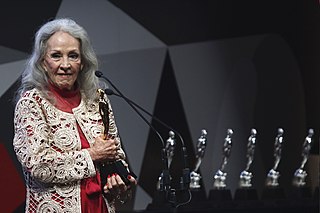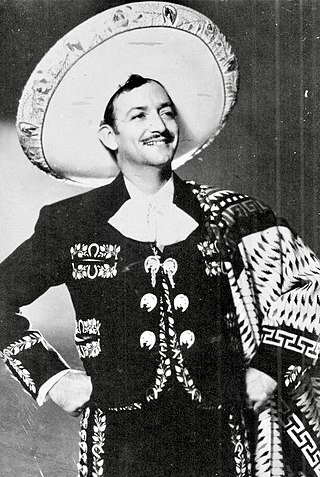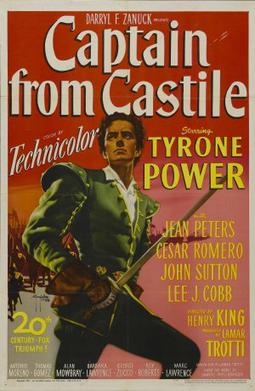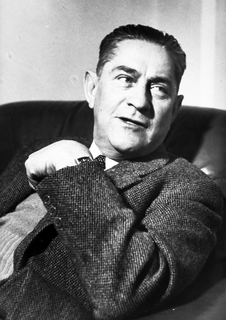This article needs additional citations for verification .(May 2019) |
A list of the films produced in Mexico in 1946, ordered alphabetically (see 1946 in film):
This article needs additional citations for verification .(May 2019) |
A list of the films produced in Mexico in 1946, ordered alphabetically (see 1946 in film):

The Three Caballeros is a 1944 American live-action and animated musical propaganda anthology film produced by Walt Disney and released by RKO Radio Pictures. The film premiered in Mexico City on December 21, 1944. It was released in the United States on February 3, 1945 and in the United Kingdom in March 1945. It marks the tenth anniversary of Donald Duck and plots an adventure through parts of Latin America, combining live-action and animation. This is the second of the six package films released by Walt Disney Productions in the 1940s, following Saludos Amigos (1942). It is also notable for being one of the first feature-length films to incorporate traditional animation with live-action actors.

Mexican cinema dates to the late nineteenth century during the rule of President Porfirio Díaz. Seeing a demonstration of short films in 1896, Díaz immediately saw the importance of documenting his presidency in order to present an ideal image of it. With the outbreak of the Mexican Revolution in 1910, Mexican and foreign makers of silent films seized the opportunity to document its leaders and events. From 1915 onward, Mexican cinema focused on narrative film.

Maria Antonieta Pons was a Cuban-born Mexican film actress and dancer. She was the first actress in the Rumberas films in the 1940s and 1950s, in the Golden Age of Mexican cinema. The Rumberas film genre offered a societal perspective on Mexico during the 40s-50s. It delved into the lives of women deemed as sinners or prostitutes, challenging the prevailing moral and social norms of their era.

The Ariel Award is an award that recognizes the best of Mexican cinema. Given annually, since 1946, by the Mexican Academy of Cinematographic Arts and Sciences (AMACC), the award recognizes artistical and technical excellence in the Mexican film industry. The purpose of the Ariel recognition is to stimulate and increase the excellence of Mexican cinema, favor the growth of the industry, and promote the meeting and strengthening of the national film community. It is regarded as the most prestigious award in the Mexican film industry and considered Mexico's equivalent to the Oscars of the United States.

Jorge Alberto Negrete Moreno was a Mexican singer and actor.

Pedro Gregorio Armendáriz Hastings was a Mexican-American film actor who made films in both Mexico and the United States. With Dolores del Río and María Félix, he was one of the best-known Latin American movie stars of the 1940s and 1950s.
Paul Sawtell was a Polish-born film score composer in the United States.

Leon Errol was an Australian-American comedian and actor in the United States, popular in the first half of the 20th century for his appearances in vaudeville, on Broadway, and in films.
Roberto Gavaldón was a Mexican film director.
The Golden Age of Mexican Cinema is a boom period in the history of Mexican cinema, which began in 1936 with the premiere of the film Allá en el Rancho Grande, and culminated in 1956.

Chris-Pin Martin was an American character actor whose specialty lay in portraying comical Mexicans, particularly sidekicks in The Cisco Kid film series. He acted in over 100 films between 1925 and 1953, including over 50 westerns.
Manuel Esperón González was a Mexican songwriter and composer. Along with the famous Mexican author Ernesto Cortazar, Esperón cowrote many songs for Mexican films, including "¡Ay, Jalisco, no te rajes!" for the 1941 film of the same name, "Cocula" for El Peñón de las Ánimas (1943), and "Amor con amor se paga" for Hay un niño en su futuro (1952). Other Esperón compositions have become Latin standards such as "Yo soy mexicano", "Noche plateada" and "No volveré", which was used in the first episode of the 2001 soap opera El juego de la vida. Among other performers, Pedro Infante, Los Panchos, and Jorge Negrete have made his songs well-known. His fame in the US derives from when his song The Three Caballeros was used in the Disney film The Three Caballeros (1945).

Irasema Dilián was an actress. Born in Brazil to Polish parents, she began her film career in Italy, and appeared in Italian, Spanish and Mexican films.

Captain from Castile is a 1947 American historical adventure film. It was released by 20th Century-Fox. Directed by Henry King, the Technicolor film stars Tyrone Power, Jean Peters, and Cesar Romero. Shot on location in Michoacán, Mexico, the film includes scenes of the Parícutin volcano, which was then erupting. Captain from Castile was the feature film debut of Jean Peters, who later married industrialist Howard Hughes, and of Mohawk actor Jay Silverheels, who later portrayed Tonto on the television series The Lone Ranger.

Ernesto Alonso was a Mexican producer, director, cinematographer and actor. He was nicknamed "El Señor Telenovela" because most of his work centered on telenovelas known around the world.

María Esther Fernández González was a Mexican actress.

Fernando de Fuentes Carrau was a Mexican film director, considered a pioneer in the film industry worldwide. He is perhaps best known for directing the films El prisionero trece, El compadre Mendoza, and Vámonos con Pancho Villa, all part of his Revolution Trilogy on the Mexican Revolution.
The Rumberas film was a film genre that flourished in Mexico's Golden Age of Mexican cinema in the 1940s and 1950s. Its major stars were the so-called rumberas, dancers of Afro-Caribbean musical rhythms. The genre is a film curiosity, one of the most fascinating hybrids of the international cinema.

The Lone Wolf in Mexico is a 1947 American black-and-white mystery-adventure film directed by D. Ross Lederman for Columbia Pictures. It features Gerald Mohr as the title character, detective Lone Wolf. Chronologically the third-to-last Lone Wolf film in Columbia's theatrical series, it was followed by The Lone Wolf in London later in 1947 and The Lone Wolf and His Lady in 1949.